Statue rubbing is usually a self-evolved practice performed by tourists, believers, and other people who ascribe a deeper meaning to the action of touching sculptures.
I’ve witnessed the phenomenon in a variety of versions, from churchgoers rubbing Christ‘s statue during Maleldo, the Cutud crucifixion festival in the Philippines, to hordes of tourists placing their hands in the Mouth of Truth in Rome.
Statues are typically rubbed for good luck, better love life, health blessings, or as a ritual of making any kind of wish
Then there are those statues you just “have to” rub, because of peer pressure. What kind of tourist would you be if you would just pass by Il Porcellino, the famous Florence boar, or the bronze plaque of the martyr Saint John of Nepomuk on Charles Bridge in Prague? If you don’t join the touching frenzy, you might never return to these towns, and you certainly don’t want that kind of curse on your soul!
Most of the deeper meanings behind statue rubbing, unlike the touch, are intangible. Rubbing is not a medicine delivered behind the counter, it doesn’t come with any guarantee, and the results are highly speculative.
One could (or would need to) believe it would bring good luck, love, better health, or just simply grant a wish. Because it happens in the sphere of superstition (or belief, if the realistic approach to wording offends you), the interpretation of the action can vary too.
After all, kissing icons at the Greek orthodox monasteries of Mount Athos, and simulating sex acts with South Korean statues in Jeju Loveland, are two radically different contexts. Those contexts explain what is and what is not appropriate. The same action may be perceived as desecrating in some circumstances, and as plain fun in others.
In this article, we dive deeper into the controversial practice of statue rubbing, as well as reveal the most rubbed statues in the world!
Rubbing the breasts of a feminist icon
On February 28th, 2023, travel author Boris Veličan was hoping to launch a new statue-rubbing tradition in Zagreb.
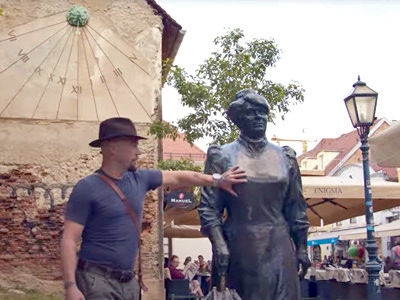
For the Croatian National Television series, he took on a role of a tour guide, showing unsuspecting visitors Croatia as never seen before.
He presented them with an invented “tradition” which supposedly makes one’s dreams come true: rubbing the breasts of the Marija Jurić Zagorka statue.
The act caused quite a stir among feminists, tourist guides, and the general public. Zagorka was the first Croatian female journalist and an important women’s rights advocate.
Veličan’s statue rubbing was rubbing salt in an existing wound. It was received as distasteful, disrespectful, degrading, sexist, misogynistic, primitive, and not at all amusing, which seemed to have been the author’s intention.
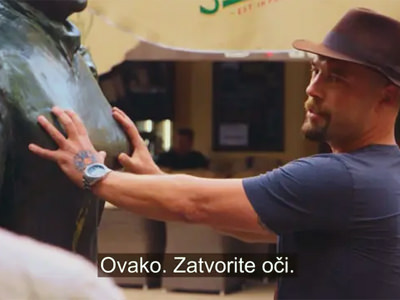
“On Youtube reels, I saw that there was a custom in Verona to rub Juliet’s breast and that it fills with happiness those who come there and do it”, sank even deeper Boris later. “Today, so many tourists flock there that they are given five seconds each to take a photo and move on. Probably under this influence, I dreamed that I could do it in Zagreb, and I dreamed of Marija Jurić Zagorka’s breasts. It came true, and I wanted to share that incredible happiness with tourists. I see no reason for hatred, and that we don’t have a such custom in Croatia.”
It was sad watching the embarrassing fiasco of a person who supposedly traveled the world and still couldn’t understand the strong public backlash. The degrading tradition of groping Shakespeare’s fictional character was hardly comparable to making an utterly unsuccessful joke with a feminist pioneer. Nobody laughed at it, and nobody would be inspired to continue his proposed custom.
For more jaw-dropping experiences that will make you wonder, read the 6 biggest WTF moments of my travels!
Why do people rub statues?
The aspiring Croatian trendsetter who wanted tourists to have a physical experience with Zagorka’s statue instead of it “only being loved by pigeons with their feces” (as he explained in an interview), did not fully understand what’s needed for launching a tradition. So why do people really start rubbing some statues?
It’s a hard question, but we can speculate about possible answers.
1. Because this is how people are wired.
Touch is one of the first senses to develop in babies, providing them with vital information about their environment, and helping to soothe and calm them. It is an essential way of learning about the world’s textures, shapes, and sensations.
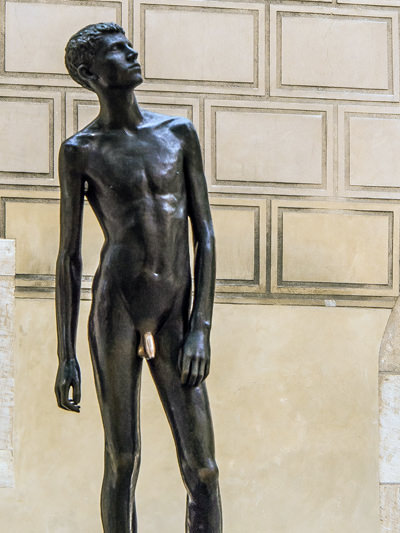
Protruding or hollow parts of objects are especially inviting for tactile interaction. Therefore, it is not unusual that those dangerous holes in the electrical outlet come with a siren call for the little fingers of our infants.
The primary development of touch could contribute to our desire for tactile experiences as adults, from observing someone’s tattoos by touching them, and feeling the texture of fruit in the supermarket, to – rubbing statues. By touching, we establish a powerful physical connection, which can be satisfying and rewarding.
Tactile experience grounds us and makes our conclusions believable, just like the doubting Thomas could not fathom the resurrection of Jesus without poking the Messiah’s wounds with his fingers first.
2. Because people are inclined to the concept of magic.
The reason for rubbing statues could be related to the concept of sympathetic magic, which is based on the idea that like produces like. Touching a statue may be seen as a way of transferring the qualities or characteristics of the statue to the person doing the touching.
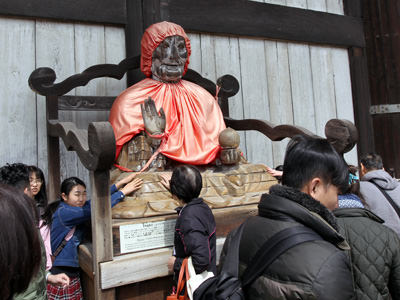
For instance, rubbing a knee of a saint may be seen as a way to acquire the saint’s healing powers in that area. Touching Ripley‘s fertility statues would obviously make you pregnant, rubbing Juliet‘s breasts in Verona would bring happiness in love (as she is a character in a romantic tale), and businessmen rubbing their briefcases against the Wall Street‘s Charging Bull statue’s testicles could expect a fertile financial future.
Now, you might think that’s just plain ridiculous. But our naive superstitions sometimes brought us results that would reinforce these magical properties.
As I’ve learned in Basel Pharmacy Museum, one of the best museums in Basel, Switzerland, even the history of medicine explored this principle. For instance, we were using heart-shaped leaves to cure hearts, scorpions to heal wounds made by pointed objects because they had the pointed shape of a sting, or earthworms to treat abdominal pain because their curled shape resembled intestines.
Similarly, by rubbing statues, we might feel as if we are connecting with essential qualities these statues represent.
3. Because statues are in a public space.
People could feel they are allowed to rub statues because of their placement in a public space. Unlike the art galleries (remember that viral scandal in Indonesia?), where most people are aware of the appropriate behavior, town squares and streets seem to stimulate our feeling of unrestrained freedom.
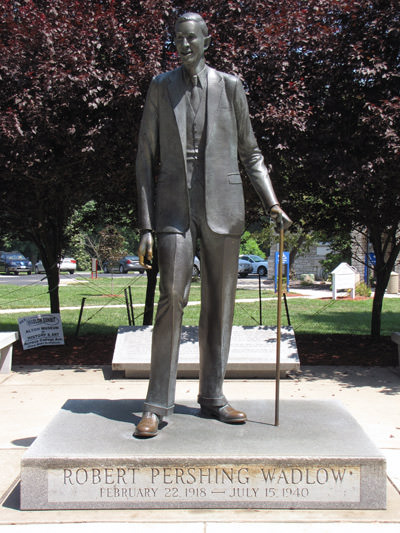
In museums, we are taught about the rules of the experience as soon as we enter. Firstly, we pay an admission ticket, which makes us accountable. Maybe we even pass through a metal detector door. When finally facing the artwork, we find barriers separating our and their world, from rope fences to glass.
Indoor statues are usually properly lit and protected with alarm that will pierce our eardrums if we suddenly think of “seeing” the art from up close.
Around public statues, on the other hand, we do not typically see guards or other alert personnel. The statues are easily reachable, and available for any outdoor influence, from rain to pigeons, so we could easily think that we are allowed to have some tactile exploration of their surface.
4. Because people imitate each other.
It is quite probable that statue rubbing is influenced by the psychology of imitation. Social or observational learning is a process by which people adopt new behaviors or attitudes by observing the action of others.
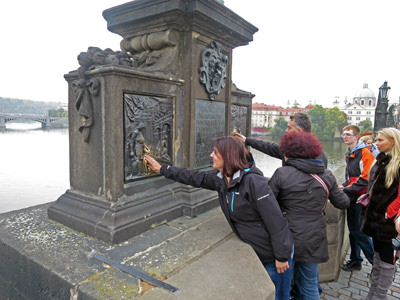
Whether there is a social norm, a cultural expectation, or the desire for social acceptance or approval, we engage in behaviors that imitate others, especially when we are uncertain about what to do or how to behave.
Seeing other people rubbing a statue might make us do the same thing in order to conform, or participate in a shared experience or connection.
In the social media era, taking photographs of expected motives at certain “must-visit” sites reinforces the widespread and enduring behavior of statue rubbing.
5. Because people (believe they) are instructed to rub statues.
Sometimes, authority figures such as tour guides or religious leaders could be powerful motivators for engaging in statue rubbing. When the figure of authority tells us to do something, directly or indirectly, we may feel obligated or compelled to follow through with the request, even if we are uncertain about potential benefits.
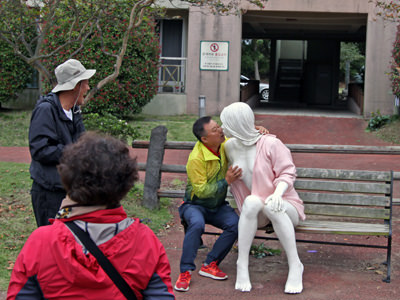
People might be encouraged to statue rubbing as a way to show respect or reverence, as a method to gain good luck or other blessings, which can be appealing to some. Also, if we are presented with behavior like a common practice, we might feel pressure to follow through with the instruction in order to not offend or appear rude.
The knowledgeable authorities could even make us believe that parts of the bronze statue are golden for a reason. Gold, as a precious material that is valued for its rarity and beauty, is associated with wealth, prosperity, and divine power, so it could definitely influence our decision on engaging in statue rubbing.
However, that’s a sort of feedback loop, as people rub parts that seem to be golden, but also those parts are “golden” exactly because people frequently rub them.
Why do statues turn gold when rubbed?
Rubbing makes bronze statues turn gold because gold is actually the natural color of bronze.
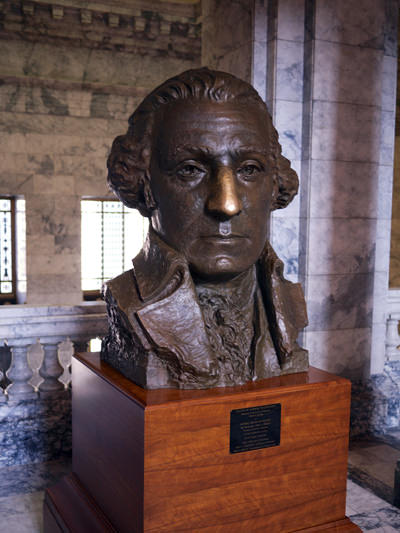
Statues typically have a patina, the outside coloring that can be made by the artist or by nature (a great example of the latter one is the green-appearing Statue of Liberty).
Bronze is mostly made of copper, and when it’s exposed to air, moisture, or chemical processes applied by the artist, its color can range from brown to black, from blue to red.
Natural oxidation makes bronze statues darken in appearance. However, rubbing statues effectively removes the oxide, thus exposing the true color of bronze.
Frequent touching of the statue essentially acts as polishing, taking off the natural layer of corrosion, and giving it a shiny golden appearance.
While the bronze statue is not actually coated in gold, the perception of its rubbed surface can be an added motivating factor for people to engage in statue rubbing.
The anatomy of statue rubbing, from head to toes
Let’s take a closer look at the world’s most notable examples of statue rubbing, through a thorough body scan, from head to toes.
1. Head
The superstition that rubbing a bald man’s head is a ritual that brings good luck has been practiced from US president George Bush and boxing legend Muhammad Ali to French footballer Laurent Blanc during the 1998 World Cup. This widespread belief in the magical properties of hairless men is not that far from associating similar benefits with polishing statue heads.
The manhole marvel
In the world of statues, their feet are a more common object of worship than heads, simply because they are normally more easily available to passersby.
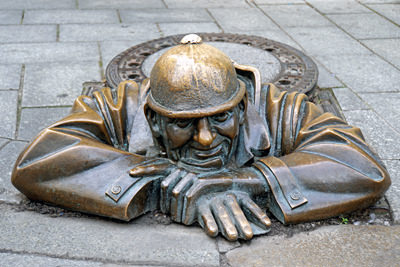
A rare but notable exception is the Čumil (Chumil) sculpture in Bratislava, Slovakia, simply because it’s positioned at street level. Depicting a cheerful man emerging from a manhole, the bronze statue by Viktor Hulík represents a worker maintaining the city’s underground sewer system. With a smile on his face, he enjoys the view at the corner of Laurinská and Panská streets.
Since 1997, when the statue was installed in the Old Town, it became a good luck charm of sorts. People spontaneously started rubbing Čumil’s head hoping to absorb his positive energy, and maybe even fulfill a wish or two.
The plumber’s power of attraction is so magnetic that already a couple of cars ran over him, and broke him to pieces. As a result, Čumil even got his own “Man at Work” road sign.
The beard of fortune
In Havana, there’s a local celebrity who’s been immortalized in bronze, and it’s not Fidel Castro. In front of the convent of San Francisco de Asís, the statue of a street man that roamed the capital of Cuba in the 1950s was erected.
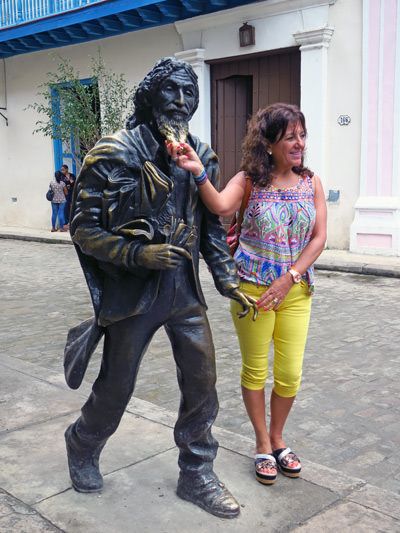
José María López Lledín was better known by his nickname El Caballero de París (the gentleman from Paris). Always dressed in black, with long fingernails and a scruffy appearance, he was a friendly and talkative person but lost his marbles when he got arrested for a crime he did not commit.
El Caballero never begged, accepted only exchange of money for little gifts he was making and was even giving change to those who gave him cash. He was always available for discussions on the meaning of life, religion, and politics.
The sculpture made by José Villa Soberón is now a reminder that one can find fortune when one least expects it. Those who make a wish while rubbing the gentle knight’s whiskers will have their wish granted.
Rubbing the wrong head
Not every statue rubbing on its head will bring blessings. As a Pennsylvania teenager found out in 2014, touching the head of a statue could be interpreted as desecration, potentially leading to two years in prison.

The 14-year-old simulated a sex act with the statue of a kneeling Jesus in Everett, on the church lawn of the Christian group Love in the Name of Christ. Standing in front of the statue considered to be a venerated object, he suggestively posed with Christ’s head in front of his crotch and then posted the photograph on Facebook.
The naughty offender pleaded guilty in court and apologized for his behavior. The judge sentenced him to 350 hours of community service, a six-month ban on social media, and a 10 pm curfew during the probation.
As tempting as their heads might be, it’s important to remember that not all statues are created equal. Always think before you rub: will it bring you good luck or court date?
2. Nose
Now we get to finer details. As typically the most protruding part of a head, a statue’s nose has practically an open invitation for rubbing written on it. Especially when we talk about busts, which means statues without otherwise rubbing-appealing legs.
Abraham Lincoln’s nose job
Among the most notable statues with rubbed noses is the massive bronze bust of Abraham Lincoln, the 16th president of the United States. Placed in front of Lincoln’s Tomb in Springfield, Illinois, back in the 1930s, the dark statue’s nose was getting shinier and shinier over time, after a million hands engaged in a silly act of holding a president’s nose.
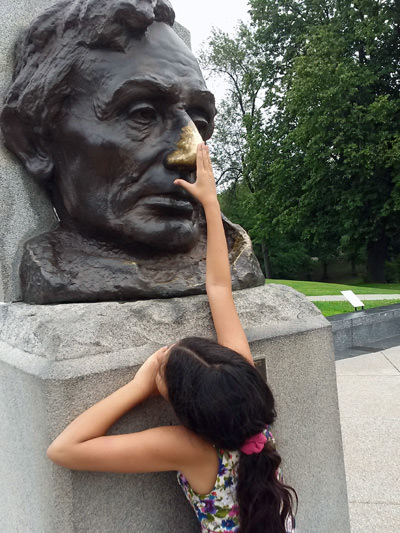
The statue caretakers at Oak Ridge Cemetery were worried that constant rubbing would damage Lincoln’s nose to extent that no nose job would be able to mend it. In the 1970s, the statue was elevated to a hardly reachable height. The protest of local children successfully returned America’s favorite nose to its original position.
The author of Lincoln’s bust is Gutzon Borglum, the same sculptor responsible for the design of the presidential stone faces at Mount Rushmore. Aren’t you glad kids don’t have to do alpinism in order to reach the Lucky Nose?
Nobody knows who started the tradition of Lincoln’s statue rubbing, but when someone did it first at the second most visited cemetery in the country, the custom quickly picked up. The result is the glowing nose that, according to folklore, will bring good luck, and even share some power and wisdom of the Honest Abe if you look into his eyes while rubbing it.
Other U.S. noses worth picking
The nose of the first US president George Washington supposedly also transfers some good luck. You can find his bust at Washington State Capitol Building in Olympia.
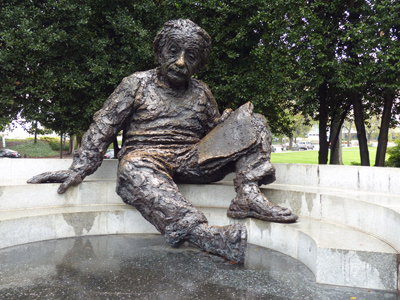
To boost your intelligence, visit Albert Einstein Memorial in Washington, D.C. One of the greatest scientists in the world got a triple-sized statue made by Robert Berks in 1979. Visitors love climbing it, but those who rub Einstein’s nose could potentially become smarter.
At Dartmouth College in New Hampshire, there is another statue nose rubbing tradition, popular among students. Rubbing the nose of Warner Bentley‘s bust at the Hopkins Center for the Arts allegedly brings good luck at racecar speed.
This custom sprang off from an earlier one in the 1930s; back then, students were seeking luck while rubbing the nose of the statue of dean Craven Laylock. This one was the most famous for punishing the student Theodor Geisel for drinking during Prohibition by kicking him out of the college’s humor magazine. And that’s how the pen name Dr. Seuss was born.
Nose for European literature and art
On the other side of the Atlantic, the writers’ noses bring luck to passersby. In Lodz, Poland, the star of the nose rubbing is the poet Julian Tuwim, another major figure in children’s literature. The monument of him sitting on the bench was constructed by the sculptor Wojciech Gryniewicz in the late 1990s.
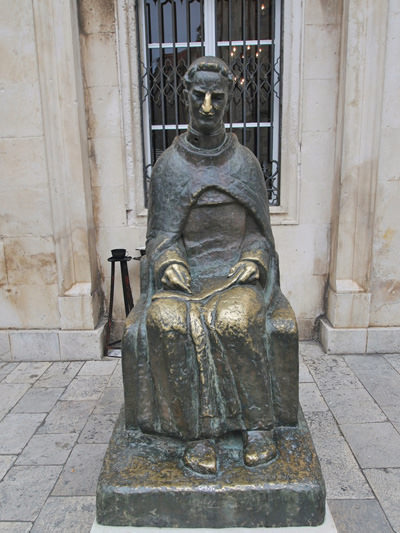
In Dubrovnik, Croatia, now best known for the “Game of Thrones”, the famous Renaissance playwright Marin Držić sits on a throne that attracts equal attention. Even if locals are not the happiest about the custom, visitors keen on statue rubbing recognized the value of the oversized nose proposed by the sculptor Ivan Meštrović. In order to gain happiness, good luck, and hopefully a return visit to Dubrovnik, tourists added their touch to the artwork.
People of Saint Petersburg, Russia, love to rub the noses of the characters from novels. Especially popular are the statues of the Good Soldier Švejk (Jaroslav Hašek) and Ostap Bender (Ilf & Petrov).
In Cologne, Germany, rubbing the noses of the statues made after puppet characters Tünnes and Schäl should bring a smile to your face, just like the jokes about them would.
3. Arm
Judging by the golden hue of the entire Everard t’Serclaes Monument, one wouldn’t easily conclude that it is rubbing the statue’s arm that brings luck to the rubber.
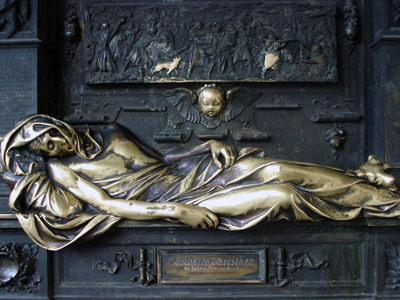
The visitors of Grand Place in Brussels, Belgium, thoroughly massaged the body of the national hero along and across, so it remains one of the shiniest statues on this list. That’s probably thanks to the length of the exposure to rubbing, as the sculptor Julien Dillens created this memorial back in 1898.
In the 14th century, Everard t’Serclaes was a local patriot who successfully recovered Brussels from Flemish hands, but three decades later was brutally murdered by the orders of a Brabant lord.
Today, the legend survives that anyone rubbing the arm of the statue will not only be granted a wish but also secure the return to Brussels. In a dedicated search for good luck and love, tourists also rub other parts of the monument – notably the shield, the dog, and the angel’s face.
The Belgian capital has some impressive landmarks to explore. From Manneken Pis to Atomium, Brussels monuments are worthy of your attention.
4. Finger
Despite what we learned from the James Bond movie, the goldfinger is not always the bad guy. Sometimes, the real finger with a golden sheen can bring better things than trouble.
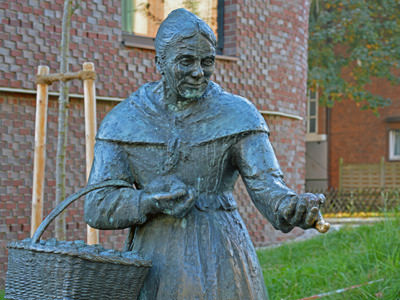
The first finger worth touching is the one belonging to Zitronenjette, the popular lemon seller in Hamburg. By real name Henriette Johanne Marie Müller, this woman became a local legend at the end of the 19th century, but due to issues with alcohol, she was institutionalized in an asylum.
In 1986, the sculptor Hansjörg Wagner dedicated a memorial to this small woman (she was 1,32 meters tall and had less than 35 kilograms) whose fame overgrown her. At Ludwig-Erhardt-Straße, near St. Michaelis’ Church, she still holds a basket offering lemons, but no longer yells “Zitron! Zitron!” to passing customers.
Occasionally attacked during her time, the woman whose life was as sour as lemons now brings luck to pedestrians who rub her finger. What more could you ask from a touching story?
In the neighboring town of Mölln, one can find another original character offering the finger with a golden glimmer for a good good-luck rub. Till Eulenspiegel was a trickster of the 14th century, playing hilarious practical jokes that propelled him into a folk hero. To soak up some of that cheerful energy, give his thumb a good rub!
Who knew all it took for good luck was a bit of finger action?
5. Breasts
We’re now getting to a more controversial body section in this guide through statue rubbing. Okay, maybe you didn’t expect that incident with Christ’s head, but statues with female breasts generally get assaulted more often.
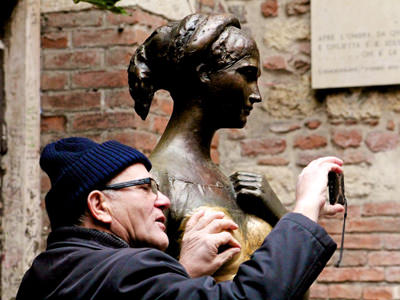
#Juliettoo
First stop: Verona, Italy. Casa di Giulietta or Juliet’s House is an invented home of the famous Shakespeare character. In the courtyard of the house, tourists gladly participate in a boob-grabbing ritual that brings significant income to the town. The centerpiece is Juliet’s statue made by the sculptor Nereo Costantini, placed here back in 1972.
Drawn by the legendary tragedy of forbidden love, visitors patiently wait for their five seconds of selfie fame. As the custom instructs, one needs to grope Juliet’s right breast in order to receive benefits in love life.
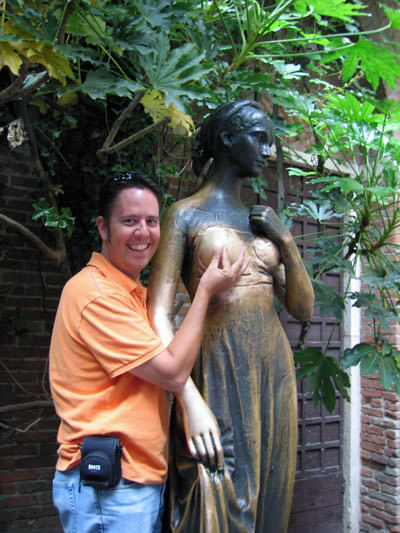
The cringy tradition that encourages adults and children to fondle the breasts of a teenager (the fictional character committed suicide when she was 13), all in a cheerful atmosphere, is a bizarre example of culture used as an excuse for promoting the most doubtful ideas.
Sure, one could say it’s just a statue, it’s fiction, it’s all Disneyland. But even in Disneyland, the content is not produced around grabbing Sleeping Beauty’s boobs as a wake-up call.
In 2014, poor Juliet herself couldn’t handle it anymore. Constant caressing made holes in her chest, and she had to be removed, and replaced by a substitute (made by Novello Finotti).
In 2020-2021, small plaques requesting visitors not to touch Juliet have been placed, with no special effect. Now that visitors are back, it’s ‘touch as much as you want’ again.
As Instagram reveals, it’s pretentious to believe that people who sometimes did not even read the book, would have enough courtesy to read – a warning sign.
View this post on Instagram
What is considered harmless behavior in Italy (and accidentally a lucrative business), is a serious red flag in countries that experienced the #metoo movement. When dr. Jon Einarsson, a surgeon from Boston, proudly showed his Juliet-rubbing photograph during his presentation at a 2017 gynecology conference, he received a furious response that consequently outed widespread sexual harassment and assaults in the industry.
Breast wishes
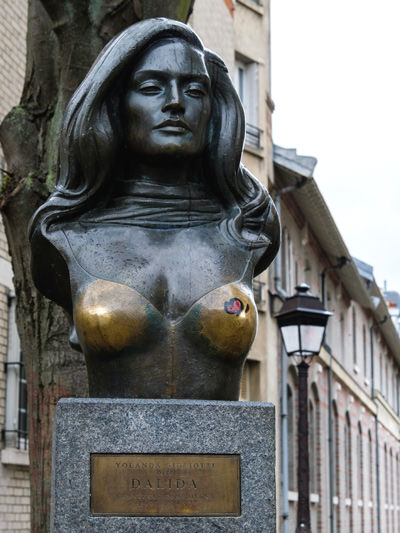
Not to an extent of Italian Juliet’s popularity (before the pandemic she was attracting 3 million tourists to Verona per year!), European cities still have their solid candidates for statues with frequently rubbed breasts.
Paris, for instance, has a statue of Dalida, created by the sculptor Aslan. France’s bestselling singer Iolanda Cristina Gigliotti – Dalida had a successful career, but also a private life filled with traumas. After three of her lovers and a close friend committed suicide over the years, the queen of French chanson also took her life in 1987. On the tenth anniversary of her death, the city named a small square in the Montmartre district after her and adorned it with her bronze bust. Pretty soon, people started rubbing her breasts, for “good luck”.
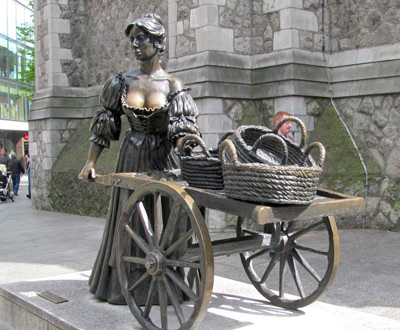
Dublin also has its statue with ample assets – Molly Malone. The capital of Ireland erected the sculpture by Jeanne Rynhart during the 1988 Dublin Millennium celebrations. They wanted to commemorate the 17th-century legend of a woman that was selling fish by day and body by night. While the sexualized appearance of the statue was criticized among locals, the tour guides’ idea that rubbing her breasts brings good luck caught up. Now, the bossom’s shine is a reliable yardstick for measuring the success of the tourist season.
Munich, in Germany, has Juliet’s twin (cover image of this article), which was a donation of Verona in 1974. While German admirers did not grope the statue to the extent that one would think she wears a golden dress, it is very obvious where they focused their tactile attention. Rubbing the right breast will of course gift you with eternal love. If you place flowers in her hand, you will double your chances. You can find Juliet’s statue on the southern side of the Altes Rathaus (the Old Town Hall).
6. Belly
Rubbing bellies for good luck may sound like a strange concept, but it’s a belief that survived centuries, from temples of Asia to the streets of Europe. Forget the lottery and meet the bellies full of luck!
Stockholm hotspot
I don’t know if women that inspired bosomy statues would be glad to know that they became the rub victims of men with wet dreams and dry-lipped female enablers.
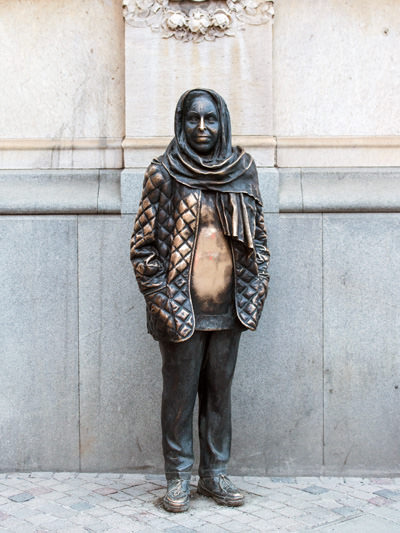
For Margaretha Krook, we know with certainty that she disliked even the idea of being immortalized as a statue because she perceived them as “cold and uninviting”.
The Royal Dramatic Theatre in Stockholm, Sweden, outwitted the wishes of the famous actress by erecting a statue that would be – heated. In a way, the clever folks managed to have a cake, and (h)eat it at the same time.
At the corner of the theater building, the place where the actress used to puff on cigarettes before the show, she now stands in bronze, warmed up at comfortable 37 degrees Celsius.
Margaretha Krook’s stomach became a hotspot to resort to if you want to warm your hands or grab some good luck.
If it is true that the statue’s shiny belly grants wishes, imagine what Margaretha Krook herself would’ve asked for if she had the chance to touch it and have her wishes fulfilled!
The belly of Budapest
If you come to Hungary, one Budapest belly also promises to shower you with good luck. At the corner of Zrínyi utca and Október 6 utca, on the way to St. Stephen’s Basilica stands a statue of the Fat Policeman, sometimes referred to as Uncle Karl.
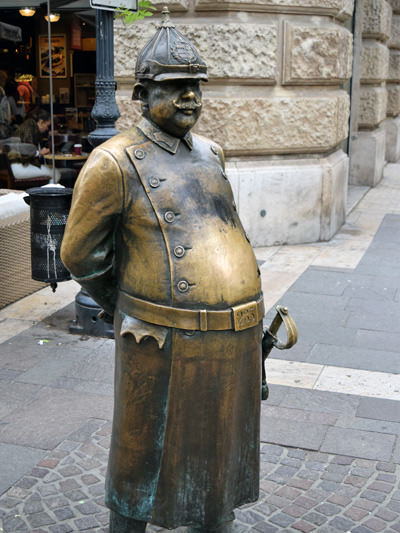
The sculptor Illyés András created the statue in 2008, inspired by the physique of his grandfather.
Hungarian lore says that rubbing the policeman’s bronze belly would bring you luck, especially in love. The other theory swears that the magical tummy touch would save you from gaining any weight while enjoying the hearty Hungarian cuisine. This diet savior has got your back (and belly)!
While you are in the neighborhood, you can start testing the guilt-free culinary journey by indulging in rose-shaped gelatos and other mouthwatering Hungarian desserts in Budapest.
Big bellied Buddha
Besides the Budapest belly myth, there is also the global Buddha belly myth. The belief basically says that rubbing Buddha’s belly will bring you good luck, prosperity, and wealth.
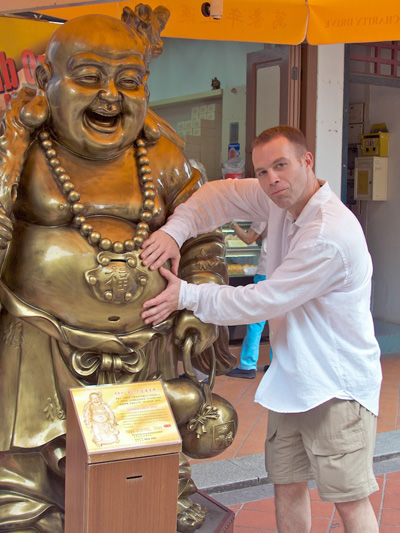
While in theory you could also rub Buddha’s head or ears, it is the large and in charge belly that does the trick. For the best of luck, look for the fattest Buddha statue on the shelf!
Not less important, it should be a laughing Buddha statue whose tummy you want to rub on a daily basis, in order to secure wealth.
Some explain that the origin of this custom can be traced to the Lingyin Temple. If their laughing Buddha statue helped them become one of China‘s largest and wealthiest Buddhist temples, why would anyone be skeptical?
You can easily find your laughing Buddha on Amazon. Get inspired by these precious options that can spice up your décor, but also elevate the good luck at your home and ensure prosperity in your life!
7. Butt
Not many places in the world could pull off a statue with butts “in your face” as Las Vegas could. For years, the backsides of the scantily clad Crazy Girls were the most photographed statue in Sin City.
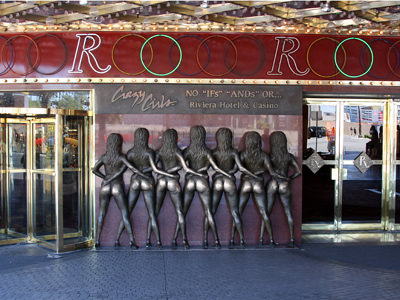
The longest-running burlesque show in the United States started at the Riviera Hotel and Casino in 1987. When the building was scheduled for demolition, the Crazy Girls moved to Planet Hollywood in 2015. They had a good run there until finally, the pandemic put a halt on this entertainment reserved for adults.
The statue named “No Ifs, Ands, or Butts” was created by Michael Conine in 1997. It was welcomed by protests from feminist organizations. But as controversy only adds to the allure, the statue with butts managed to become a tourist attraction. The iconic photo-op landmark was moving with the show and was packed into storage after it ended.
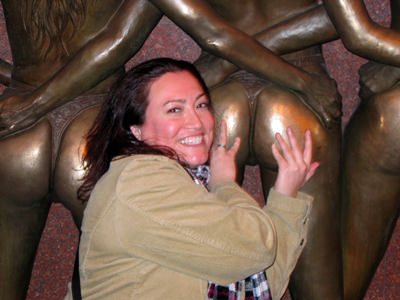
The bronze derrières in G-strings belonging to the seven showgirls standing together were polished to a high shine over the years. With the odds stacked against them at casino tables and slot machines, it’s no wonder that people tried to multiply their luck by rubbing the Crazy Girls’ butts. Or maybe the gambling was just an easy excuse for raunchy behavior? In any case, the glowing behinds are silent witnesses that millions of people hoped to get hold of millions.
The bootylicious statue might have brought a fortune to some believers, but the R-rated show that was putting the strip on Las Vegas Strip, unfortunately, had to shut down. Together with the spectacle, the bronze rear ends also came to an end, waiting to be resurrected at some new venue.
8. Penis
While some might see male statues as works of art to be admired from a distance, others feel compelled to get up close and personal with certain parts of the anatomy. Yes, we’re talking about the statues with particularly prominent crotches that seem to draw the attention (and hands) of passersby.
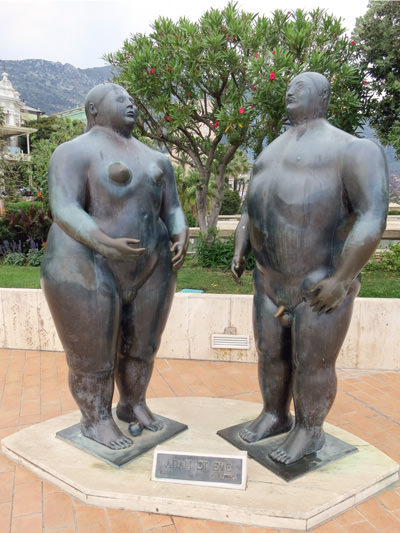
Rubbing the forbidden fruit
Unlike Las Vegas visitors, European gamblers prefer rubbing male body parts to raise their chances of winning. In Monaco, the lucky charm is the penis of Adam!
Fernando Botero‘s corpulent Adam and Eve statues were unveiled behind the Casino de Monte-Carlo in 1981. Without fig leaves hiding the private parts, there was not much left to the imagination of those seeking an easy path to luck. Passersby rubbed Adam’s manhood hoping for some happy ending at the casino, and private life.
Oversized replicas of Adam and Eve, in Colombian artist’s signature figurative style, have popped up all over the world, grabbing equal attention. Adam at The Shops at Columbus Circle in New York, and the one at Plaza Botero in the artist’s hometown Medellin, also received generous handjobs from admirers.
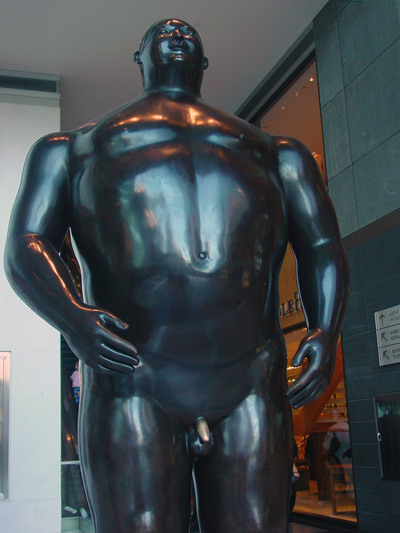
But when Singapore‘s Resorts World Sentosa, known for showcasing famous art pieces in their hotel lobby, housed Botero’s couple from Eden, it was not exposed to a rub, but to a somewhat amusing outrage. The angered guest complained to the media that the “indecent statues” were not suitable for children’s eyes, calling out Adam’s penis as huge. “It should be small if it is art”, said the shocked man.
As for children’s exposure to naked sculptures, we’re not sure how the Singaporean would react if he would see Miloš Zet‘s statue Youth erected at Prague Castle in 1965. The bronze figure of a young boy, whose well-worn penis has changed color due to good luck rubbing, has been installed in front of the – Toy Museum.
Lviv statue that’s hard to resist
Moving on from innocent victims of statue rubbing to the one that was seemingly conceived with groping in mind… For the following unusual statue, we would have to travel to Lviv, Ukraine.
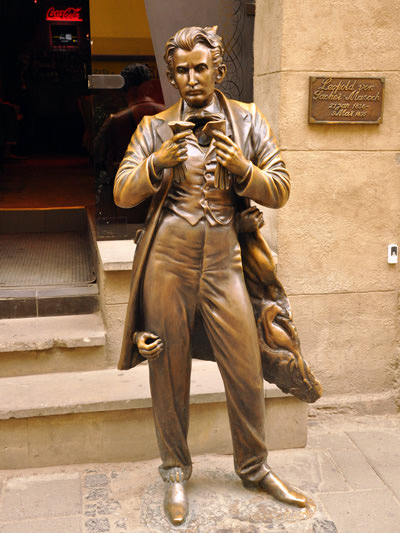
On Serbska street in the Old Town, just in front of the Masoch Hotel & Cafe, stands a monument to the city’s most famous citizen, Leopold von Sacher-Masoch.
It may happen that you do not know much of his literary work (does “Venus in Furs” ring a bell?), but you’ve certainly heard about the sexual affinity named after this 19th-century writer: the masochism.
If you don’t want to explore the pleasures of domination and submission in a whipping-allowed hotel/bar hiding behind the keyhole-shaped door (celebration of voyeurism at large!), Masoch’s statue itself has a kinky side.
Sure, you could give his crotch a little squeeze from the outside, but by now you’ve learned: that’s a child’s game. Unlike the other statues in this section, this one actually holds an inner secret. For the full experience, slip your hand into his left pocket, and you’ll be able to explore his entire package!
Well, he is definitely happy to see you! Masoch’s private parts are as hard as bronze can get. To completely fulfill your search for good luck, you might be only missing that Swedish ingenuity – the heating.
Cristiano Ronaldo’s lucky groin
Madeira in Portugal is proud of its most famous islander. In 2014, it rewarded one of the world’s best footballers with a statue in Funchal. Since then, the bronze version of Cristiano Ronaldo has been getting significant attention from his groping groupie fans.
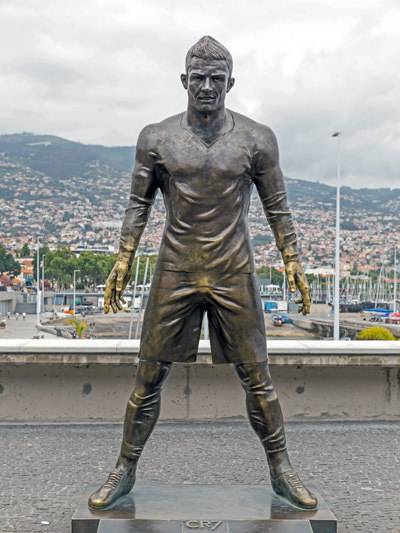
Designed by the artist Ricardo Madeira Veloso, the statue quickly drew all the gazes to its most prominent feature: the sizable bulge. And when the rubbing started, nobody could control it anymore.
Ronaldo’s groin area now shines so brightly that, if we were at a stadium, any goalkeeper would have trouble concentrating on the ball.
While messing with Cristiano Ronaldo’s real crotch on the field would get you a red card, everything seems to be permitted with his statue. Motivated by good luck, or just some plain good fun, holidaymakers in Ronaldo’s hometown don’t want to leave empty-handed.
Just like with Dalida’s breasts, touching Cristiano Ronaldo’s penis is crossing the line without fear of a penalty. It is a giggly expression of hope that some of their stardom would rub off on the rubbers, with social media bragging rights as the ultimate reward.
But hey, no judging!
View this post on Instagram
The penis mightier than the sword
Last but certainly not least in this section of molested statue crotches is actually a monumental misconduct. If he would know he has become the plaything of licentious crowds, Victor Noir would be surely turning in his grave.
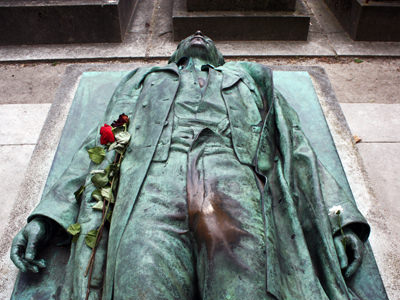
This French political journalist was murdered in an 1870 duel with Napoleon‘s cousin, prince Pierre Bonaparte, and became a sort of an adored martyr. At Père Lachaise Cemetery in Paris, his final resting place became a pilgrimage destination, where people came to honor him.
But sculptor Jules Dalou thought the best way to represent the journalist was through a statue in a lying position, with unbuttoned trousers and a noticeable bulge. There was nothing erotic in Noir’s biography, yet after his death at 22, he became a talisman for love and sexual desires.
Rubbing the statue’s swelled-up groin, exchanging French kisses with his lips, and leaving flowers in his hat (there had to be some romance; we’re in Paris, after all) is a recipe for good luck in love, blissful sex life, and fertility.
Noir’s genitals grant wishes in a timeframe of one year, or so they say. Touching his right foot will secure a pregnancy, and for ambitious mother wannabees, the left foot gets you twins.
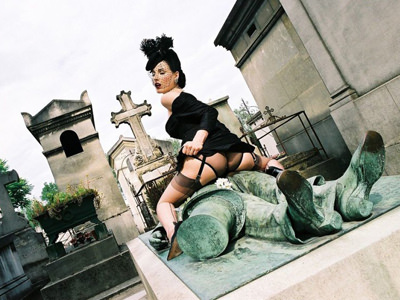
In 2004, authorities tried to stop the frenzy around the miraculous penis by fencing off the statue and putting up a sign warning that “indecent rubbing will be prosecuted”. French women loudly protested against the “attack on their rights”, and the fence was taken down.
Noir’s discolored crotch and mouth are physical proof of how the myth of a journalist’s postmortal influence is considered seriously.
From Dita von Teese to Instagram influencers, everyone seems to want to give Victor Noir’s statue a ride. Women (and the occasional man) planting kisses and simulating copulation at a tomb is probably the steamiest scene you expect to witness at an otherwise peaceful cemetery.
Check out this Instagram collection of Victor Noir’s unsuspecting mistresses!
View this post on Instagram
View this post on Instagram
View this post on Instagram
View this post on Instagram
View this post on Instagram
View this post on Instagram
View this post on Instagram
9. Knees
Knees are not exactly the most alluring rubbing zone of the world’s statues, but some did succeed at drawing attention to this body part.
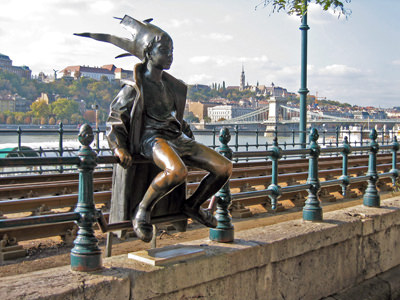
Kiskirálylány or the Little Princess is a statuette of a girl wearing a cape-like bathrobe and a DIY crown, sitting on the tram railing at Danube Promenade, near the iconic Széchenyi Chain Bridge in Budapest.
The artist László Marton modeled the sculpture after his playful daughter who loved to exercise her imaginary royal status by wearing makeshift crowns made of newspapers.
Placed in a busy pedestrian area, the statue quickly captured the hearts of Budapest. Locals passing by developed a tradition of rubbing her knees, solidifying the Little Princess as another Hungarian good luck idol.
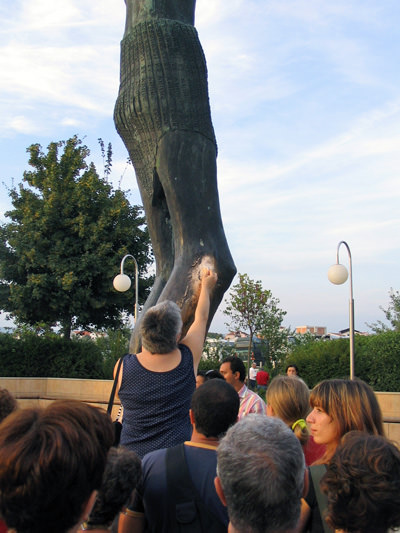
But the knees of the princess would tremble if she would see what the king does with his. In Medjugorje, the famous Catholic pilgrimage in Bosnia and Herzegovina, the statue of the Risen Christ supposedly has miraculous powers.
The statue was a donation of the Slovenian sculptor Andrija Ajdič in 1998, and for many years it has been filling up media columns with its unusual “weeping knee”. Water leaking from the bronze knee of the Son of God was celebrated for its supposed healing properties. It was worshipped by the faithful ones, collected into prayer clothes, and used to treat the sick.
Statues can indeed condensate inside, but this particular example shows that it doesn’t take much for people to develop superstitions, and interpret the world in any way that fits their beliefs.
Those water droplets from Jesus statue’s knee were proven to be “human tears”, whatever that’s supposed to mean. When it comes to statue rubbing, any statue that can cry from the knee is definitely worth a try.
10. Feet
Judging by the number of examples in our final category of statue rubbing anatomy, foot fetishism is a widespread phenomenon. Those that like to rub statues’ feet, toes, or shoes, could be broken down into several categories.
Rubbing feet for divine intervention
Bronze statues of Saint Peter are especially popular rubbing targets among Roman Catholics. Typically presented as seated, holding keys of God’s kingdom in his hand, with the right foot forward, the statue of the first among the apostles is practically asking for rubbing down below.
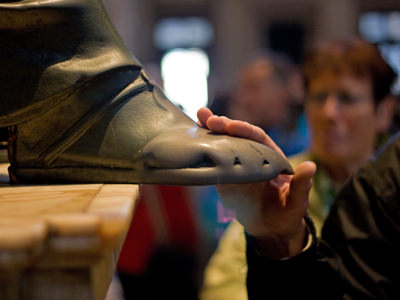
The most famous is, of course, the saint’s statue in the Vatican, at St. Peter’s Basilica, accredited to the sculptor Arnolfo di Cambio in the 13th century. But the same level of reverence receive the feet of Saint Peter’s statues in Westminster Cathedral in London and in the Church of Saint-Sulpice in Paris.
Pilgrims typically touch or kiss Saint Peter’s right foot, hoping for a blessing, and favorable treatment once they reach heaven’s doors.
Centuries of improv pedicure have worn out some of these statues so that feet not only started shining but also got deformed.
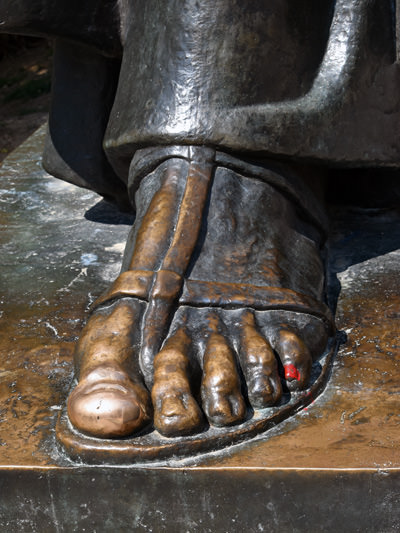
The other religious statue worth mentioning because of its rubbing aura is representing Gregory of Nin. The famous “toe of Croatia” belongs to the medieval bishop’s left foot, and receives regular rubbing by tourists seeking fulfillment of wishes and good luck.
Created by the famous monumental sculptor Ivan Meštrović, the statue moved around Split since its erection, finally settling north of the Diocletian’s Palace, close to the Golden Gate.
If you happen to be in Nin or Varaždin, it’s good to know that these Croatian towns also have smaller versions of Meštrović’s saint, with equally lucky big toes.
Next time you find yourself face-to-foot with a religious statue, don’t hesitate to give it a rub. You might get a heavenly blessing or at least a good photo for your feed!
Rubbing feet for political charisma
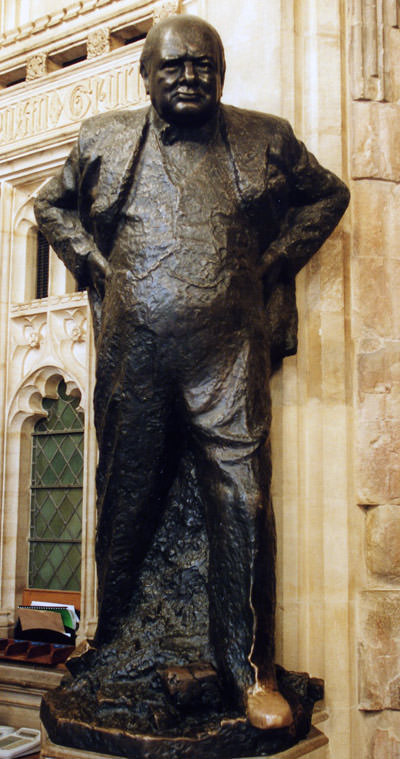
Down here on Earth, we still sometimes feel the urge to glorify the mortals. Besides dedicating statues to our political leaders, we polish their shoes in their bronze afterlife, hoping that some of their charisma could contagiously infect us.
Probably the most famous example is the statue of Winston Churchill in the Members’ Lobby of the House of Commons of the United Kingdom. The conservative members of the British Parliament developed a routine where they would rub the statue’s foot on their way to the Commons Chamber, believing it would bring them good luck and that famous bulldog spirit in political debates.
Statues of Margaret Thatcher, David Lloyd George, and Clement Attlee, experienced the same shoe-shining treatment. But eventually, serious hairline fractures and cracks were noticed in their footwear. Politicians who goldened up Churchill’s left foot were asked to control their obsessive rubbing behavior.
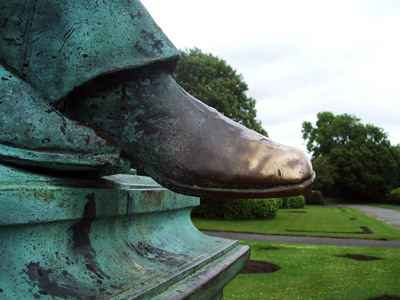
Sir Francis Powell, an English conservative politician from the second half of the 19th century, was luckier in keeping his shoe-shining fans on board. His statue was placed at Mesnes Park, in his hometown of Wigan in 1910. With his right shoe conveniently protruding from the statue’s base, Powell was an always accessible talisman whenever people needed a quick good luck boost.
And boy, did they need it! His fellow citizens felt it almost a duty not to let Powell’s foot turn green, so they’ve been rubbing off the patina with a dedicated vigor. Well, this foot massage went a bit too far. The good-luck rubs eventually created a hole in the statue’s foot! That’s some devoted fanbase.
Rubbing feet for wisdom
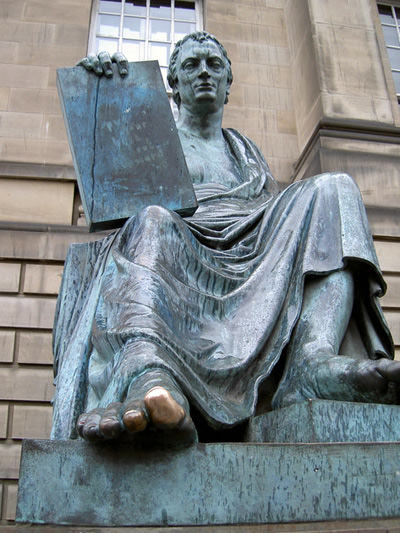
Another school of thought is intrigued by the idea that statues’ feet can channel the intelligence of the people they represent. In the vicinity of universities, they became the last resort for students struggling with tough exams.
In 1995, the sculptor Alexander Sandy Soddart depicted the 18th-century Scottish philosopher David Hume as a Greek god, wrapped in a toga.
It’s a historic irony that this Enlightenment figure, known for his strong opposition to superstitions, became a target of one.
Local philosophy students started a tradition of rubbing the right-foot toe of the statue placed at Edinburgh‘s Royal Mile, in hope of soaking up some of the thinker’s brain power.
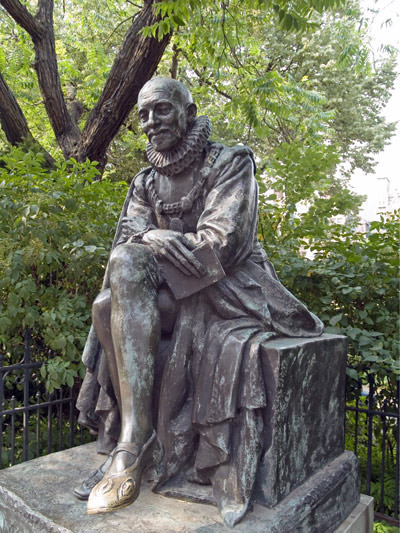
French philosopher Michel de Montaigne receives similar treatment from students of the prestigious University of Sorbonne in Paris.
The statue representing the Renaissance intellectual in a relaxed position, sitting with his legs crossed, was created by Paul Landowski, the author of Rio‘s Christ the Redeemer.
Since 1933, students seeking scholarly success ask for Montaigne’s help, by greeting the statue aloud and polishing his right shoe to a gleaming shine.
In a similar position, at Yale University, sits its former president Theodore Dwight Woolsey. Rubbing his left foot promises to bring good luck, in exams and love life, but also in boat races, whose crews Woolsey loved supporting.
According to the legend, he would push the boat off with his left foot, and the team would always emerge victorious. Beware of the right foot though, as that one seemed to be cursed with bad luck!
At Harvard University, the statue of John Harvard, the man who donated hundreds of books to the college, has a shiny left shoe.
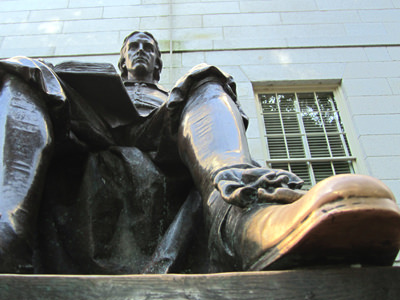
Besides rubbing, the monument made by sculptor Daniel Chester French in 1884, also received a lot of vandalism over the years, including a green paint-over by some Dartmouth students (yes, those who rub the nose!).
Today, foot rubbing of the book-holding statue is mostly performed by tourists, as students are aware of the secret pre-graduation rituals, which include naked runs, sex in the library, and, well, urinating on John Harvard’s statue. No wonder it takes up to six power-washings a year to keep it clean!
The dirty truth about statue rubbing
Atlas Biomed, a company specializing in at-home DNA and microbiome tests, conducted Europe-wide research on what we actually come in touch with when rubbing statues.
Armed with swabs and a healthy dose of curiosity, the Sherlock Holmes of the microbiome world tested 24 monuments across nine European countries. They were looking to detect microscopic creatures living on these frequently rubbed surfaces, from Juliet’s breast in Verona to Victor Noir’s bulge in Paris.
Bacteria found on frequently rubbed statues can cause eye, bladder, and follicle infections, endocarditis, and even deadly sepsis
The 2019 study found 29 different bacteria, out of which only two are normally present in the human microbiome. The dominant part of the samples consisted of opportunistic strains “that have the potential to make humans ill”.
For instance, the most abundant species was Staphylococcus, which can cause highly transmittable eye infections, bladder infections, endocarditis, and in the worst case deadly sepsis.
Then there were Pseudomonas which can endanger vulnerable immune systems, cause hair follicle infections, or even invade the bloodstream.
The continent-wide quest also showed that bacteria travel easily, and don’t mind border controls. The microbiome of Budapest’s Little Princess, for instance, was found quite similar to Dalida’s bust in Paris.
Unless you want to risk catching something nasty, Atlas Biomed experts advise washing hands thoroughly after touching any public statues. Anyone with open wounds or immunosuppression, for instance, should better avoid rubbing statues altogether.
Rubbing statues for good luck – conclusion
As we’ve seen, statue rubbing is a widespread ritual performed by people from all walks of life: from religious ones to atheists, from politicians to students, from those who do it for pure fun to those who are ready to protest for their right to rub.
We’ve covered the entire anatomy of this practice that spans from the top of the head to the little toe, with generously spent time on the private parts of the most controversial world’s statues.
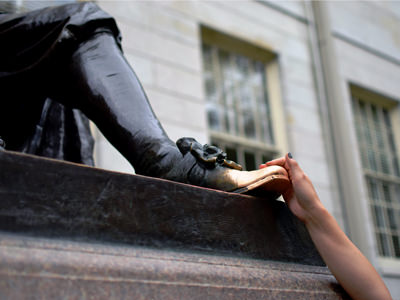
Like in a Greek myth of King Midas, we might be easily convinced that our touch turns the objects of our rubbing to gold. But the very same hands-on experience causes damage to the statues in the long term, as well as leaves potential health hazards for the next rubber. Not all that glitters is gold.
Sometimes, we can try to justify our behavior by wanting to have a first-hand experience of art. In other moments, we just want to rub shoulders with the stars. In tactile tourism, we’ve found a seemingly safe ground that allows us to “cross the boundaries”, and disconnect from the social judgment of our actions. But good luck rubs could come with a bill attached.
In some cases, touching statues can be seen as a sign of disrespect, particularly if it involves religious context or, as in the case of that Zagreb TV show on breast rubbing, if it tries to launch a tradition in a delicate political space that doesn’t see crossing every boundary as amusing.
Statue rubbing has been around for centuries. It won’t just die out tomorrow
Even in the hypersensitive times that excel at political correctness, statue hunters somehow manage to laughingly grope a teenager’s breasts or to engage in raunchy sex acts on people’s graves. Certain people can’t seem to keep their hands off the statues, and some of these monuments were just unlucky to become the symbols of good luck.
The behavior that our societies still allow today only goes to say that statue rubbing, just like other traditions, has been forming over decades and centuries. It will not just die out tomorrow.
Whether it is a quirky superstition, a tasteless habit, or mainly a germophobe’s worst nightmare, the debate about statue rubbing will probably remain. After all, it’s a touchy subject.
What do you think about rubbing statues for good luck?
Leave your comment and pin the article for later!
Disclosure: This post may contain affiliate links, which means if you click on them and make a purchase, Pipeaway might make a small commission, at no additional cost to you. Thank you for supporting our work! The cover image of this article by Goran Jakus was sourced through Depositphotos, my go-to platform for high-quality licensed stock images. They have great photo deals, so check them out! The authors of other photographs are typically mentioned in image titles and Alt Text descriptions. In order of appearance, these are: Boris Veličan - Screenshot HRT. Youth - Anguskirk, licensed under CC BY-NC-ND 2.0. Binzuru - Ivan Kralj. Robert Wadlow - anthonylibrarian, licensed under CC BY-NC 2.0. Charles Bridge - baldeaglebluff, licensed under CC BY-SA 2.0. Jeju Loveland - Ivan Kralj. George Washington - Frank Fujimoto, licensed under CC BY-NC-ND 2.0. Čumil - archer10 (Dennis), licensed under CC BY-SA 2.0. El Caballero de París - fabulousfabs, licensed under CC BY-NC 2.0. Pennsylvania teenager - Facebook. Abraham Lincoln - edenpictures, licensed under CC BY 2.0. Albert Einstein - mifl68, licensed under CC BY-NC-ND 2.0. Marin Držić - BangorArt, licensed under CC BY-NC-ND 2.0. Everard t’Serclaes - fergie_lancealot, licensed under CC BY 2.0. Zitronenjette - Illustratedjc, licensed under CC BY-SA 4.0. Juliet - ikeofspain, licensed under CC BY 2.0. Juliet - DocJelly, licensed under CC BY-NC 2.0. Dalida - Katell-Ar-Gow, licensed under CC BY-NC-ND 2.0. Molly Malone - Mark Sardella, licensed under CC BY-NC-SA 2.0. Margaretha Krook - Frankie Fouganthin, licensed under CC BY-SA 4.0. Fat Policeman - rchappo2002, licensed under CC BY-NC-ND 2.0. Laughing Buddha - brianholsclaw, licensed under CC BY-ND 2.0. Crazy Girls - brx0, licensed under CC BY-SA 2.0. Crazy Girls - bloody marty mix, licensed under CC BY-NC 2.0. Adam and Eve - deltaMike, licensed under CC BY-NC-SA 2.0. Adam - amalthya, licensed under CC BY-NC-ND 2.0. Leopold Ritter von Sacher-Masoch - Anosmia, licensed under CC BY 2.0. Christiano Ronaldo - wuestenigel, licensed under CC BY 2.0. Victor Noir - istolethetv, licensed under CC BY 2.0. Dita von Teese - Facebook. Little Princess - NH53, licensed under CC BY 2.0. Medjugorje - Lsimon, licensed under the Creative Commons Attribution 3.0 Unported license. Saint Peter - smileham, licensed under CC BY-NC 2.0. Gregory of Nin - Gwendolyn Stansbury, licensed under CC BY-NC-ND 2.0. Winston Churchill - UK Parliament, licensed under CC BY-NC-ND 2.0. Sir Francis Powell - Chris_Skoyles, licensed under CC BY-NC-SA 2.0. David Hume - Neil Owen, licensed under CC BY-SA 2.0. Michel de Montaigne - Djof, licensed under CC BY-NC-SA 2.0. John Harvard - wallyg, licensed under CC BY-NC-ND 2.0. John Harvard - Vegasjon, licensed under CC BY-SA 4.0. Discolored statues (pin image) - pthread1981, licensed under CC BY 2.0. Juliet (pin image) - DocJelly, licensed under CC BY-NC 2.0. Other images have been embedded from Instagram.

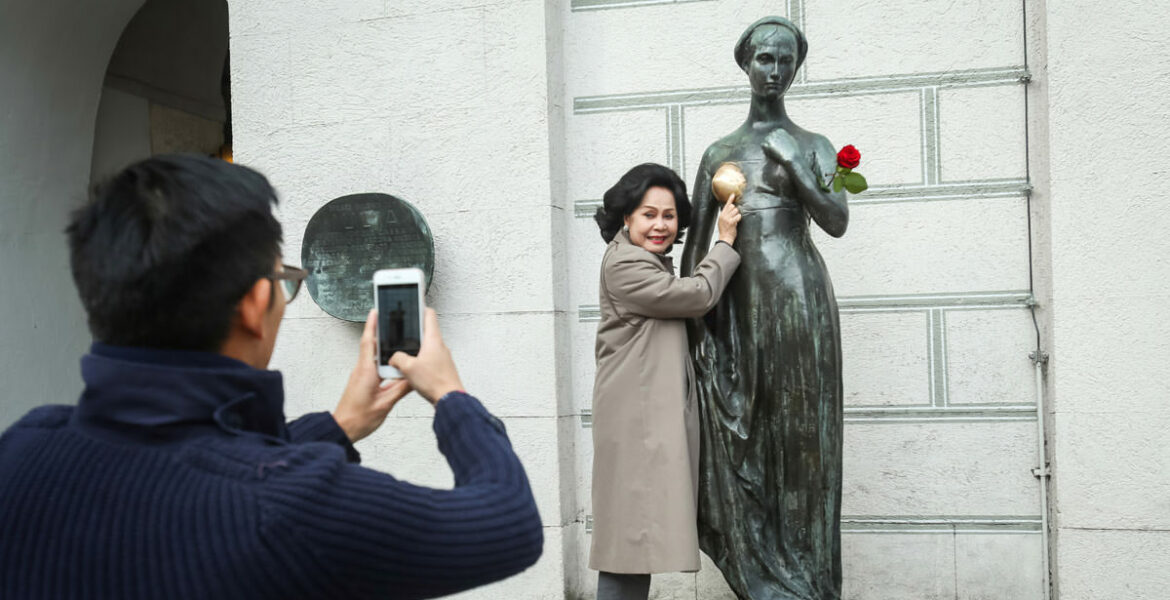
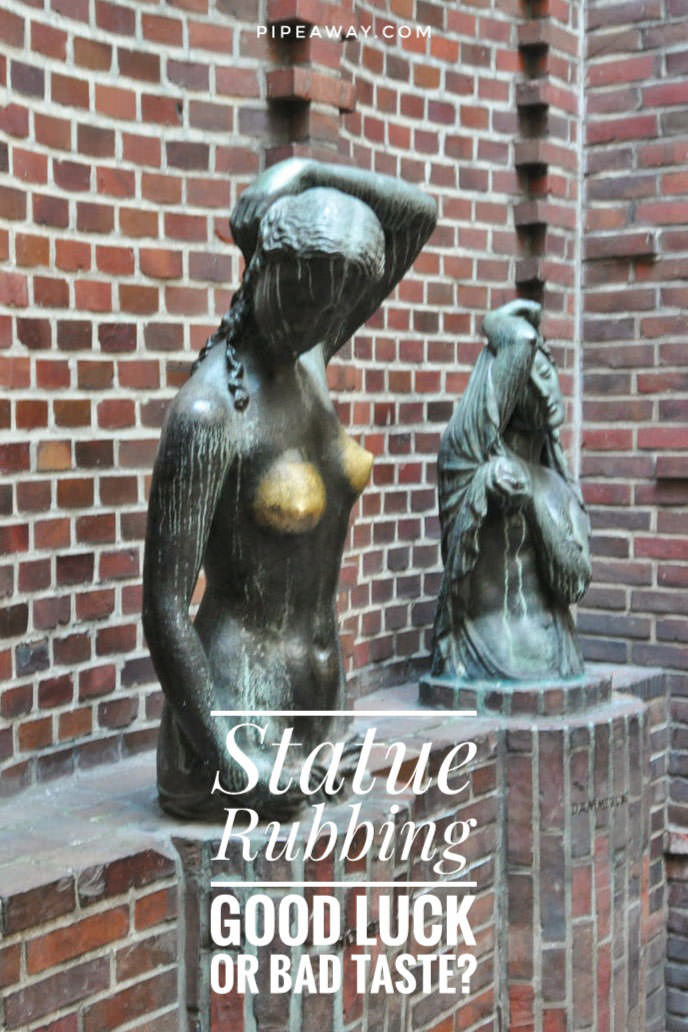


We were told by our tour guide there was a superstition about good luck from rubbing a statue’s butt in Palermo. I did it for a photo. Nope, I did not win the lottery that day….
Oh, I haven’t heard of any statue’s butt being rubbed besides those Crazy Girls in Las Vegas.
Who was the statue representing?
As for the lottery, don’t take it to your heart.
Chances for winning it are only slightly higher than gaining luck from the statue’s butt 😉
Fontana Pretoria, a.k.a. Fountain of Shame, in Palermo has a superstition to rub the butt for good luck… or else our tour guide just wanted us to get a funny photo.
Hehe, indeed. I went to google it, and the only info I could find about it was – on your website!
Who knows, maybe you have started a new statue rubbing tradition! 😉
The picture of that moron with the statue of a praying Jesus in beyond offensive !!!!! You guys are jerks for publishing it.
Dear Johnny, thank you for sharing your concerns regarding the picture we published.
We understand that the image you mentioned was highly controversial and offensive to many individuals.
It first appeared on Facebook, and was then republished on many news sites, where anyone can find it even today.
We would like to clarify that our intention was not to endorse such behavior, but rather to report on a newsworthy incident that had legal consequences.
The duty of all responsible media outlets is to inform readers about significant events happening in society, even if they may be uncomfortable or controversial.
Rubbing some other statues mentioned in this article could be equally distressing for some other readers. But that doesn’t mean that certain topics should be avoided altogether.
Also, not less important, in any public discussion, points we make can go further when we carefully choose words. That’s something everyone could advance in. Nevertheless, we appreciate your feedback.